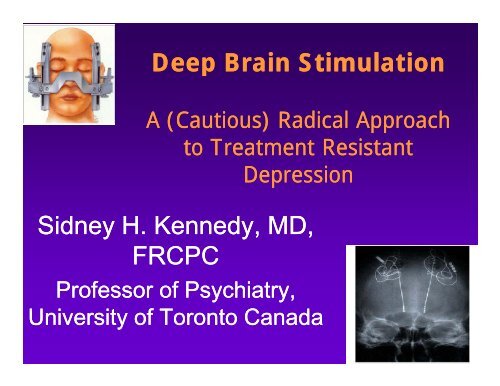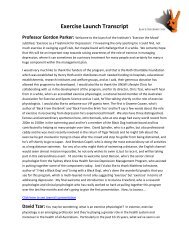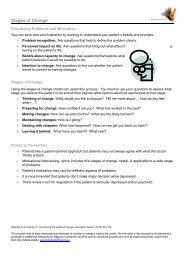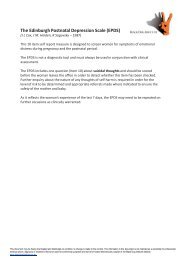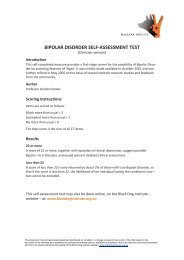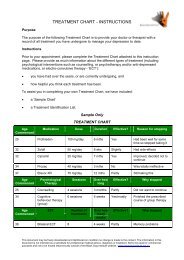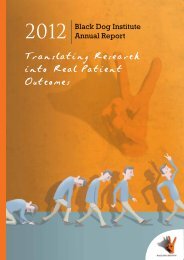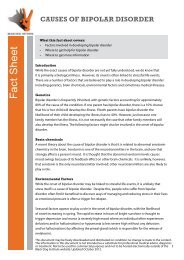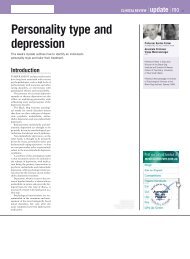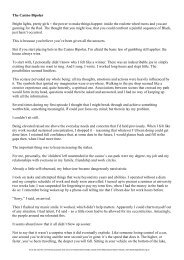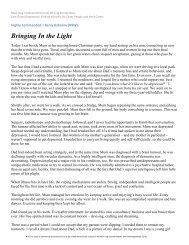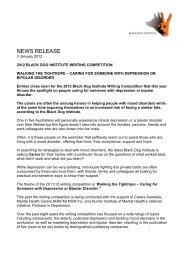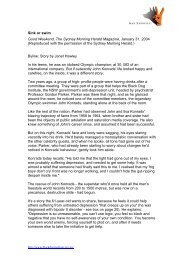Deep Brain Stimulation - Black Dog Institute
Deep Brain Stimulation - Black Dog Institute
Deep Brain Stimulation - Black Dog Institute
You also want an ePaper? Increase the reach of your titles
YUMPU automatically turns print PDFs into web optimized ePapers that Google loves.
<strong>Deep</strong> <strong>Brain</strong> <strong>Stimulation</strong><br />
A (Cautious) Radical Approach<br />
to Treatment Resistant<br />
Depression<br />
Sidney H. Kennedy, MD,<br />
FRCPC<br />
Professor of Psychiatry,<br />
University of Toronto Canada
<strong>Deep</strong> <strong>Brain</strong> <strong>Stimulation</strong><br />
• Environmental Background<br />
– Prevalence/Treatment Gap<br />
– History of Psychosurgery/Neurostimulation<br />
• Enabling Conditions<br />
– Depression Neurocircuitry<br />
– Neurosurgical Techniques<br />
• Preliminary i Results in TRD<br />
– Subcallosal Cingulate Gyrus –Toronto Trials<br />
– Alternative Targets<br />
• Cautions and Future Directions<br />
– Ethics<br />
– Evidence-based outcomes
Rationale for Neurostimulation Therapies<br />
• More than 30% of patients fail to achieve remission<br />
with current psychotherapies and pharmacotherapies<br />
• Growing recognition of recurrent-chronic-degenerative<br />
nature of major depressive disorder<br />
• Limited acceptance of ECT<br />
• Emerging models of depression neural circuitry<br />
• Advances in microsurgical techniques permit image<br />
guided interventions
Disorder<br />
Parkinson’s<br />
Disease<br />
<strong>Deep</strong> <strong>Brain</strong> <strong>Stimulation</strong><br />
Patients<br />
Treated<br />
30,000-40,000<br />
Chronic Pain 1500-2000<br />
Tremor 500-1000<br />
<strong>Deep</strong> <strong>Brain</strong> Targets<br />
Globus pallidus internus,<br />
Subthalamic nucleus<br />
Ventral posterior medial and lateral thalamic<br />
nuclei, periventricular and periaqueductal<br />
gray matter<br />
Ventralis intermedius thalamic nucleus,<br />
zona incerta<br />
Dystonia 300-500<br />
Globus pallidus internus<br />
Cluster Headache 30-50<br />
Posterior hypothalamus<br />
Epilepsy 20-50<br />
Anterior thalamic nucleus<br />
OCD 20-50<br />
Anterior limb of internal capsule<br />
Depression ~ 100<br />
Tourette’s<br />
Syndrome<br />
10-50<br />
SubCallosal Cingulate, Internal Capsule,<br />
Nucleus Accumbens<br />
Ventromedial thalamic nuclei, anterior limb<br />
of internal capsule, globus pallidus internus<br />
Modified from Pereira et al, 2007
Subcallosal Cingulate Gyrus Volume<br />
• Reduced subcallosal<br />
cingulate (BA25)<br />
volume in MDD vs.<br />
Controls<br />
• Accounted for by<br />
patients t with more<br />
than 3 untreated<br />
episodes<br />
• No differences in<br />
subgenual prefrontal<br />
cortex (BA24).<br />
• No differences for<br />
BA32<br />
Yucel et al, 2008 Drevets 2008
Subcallosal Cingulate (BA 25) in Depression<br />
Acute activation BA25<br />
in Transient Sadness<br />
Reduction in BA25<br />
Depression Recovery<br />
↑<br />
Cg25<br />
↑ ↓ +4z<br />
Cg25 ↓<br />
F9<br />
R<br />
F9<br />
- 4z<br />
Cg25<br />
Cg25<br />
Mayberg H, et al. Am J Psych 1999
DBS Effect on Cerebral Blood Flow<br />
Baseline<br />
CBF PET<br />
N 5<br />
N=5 vCd<br />
Cg24<br />
sn<br />
hth Cg25<br />
F9<br />
Cg24<br />
Cg25<br />
F9<br />
F47<br />
L<br />
z = +4<br />
3 months<br />
DBS<br />
R=3<br />
Cg24<br />
mF10<br />
oF11<br />
hth<br />
Cg25<br />
F9<br />
ins<br />
mF<br />
Cg25<br />
F46<br />
ins<br />
z = -4<br />
6 months<br />
DBS<br />
R=3<br />
bs<br />
Cg24 mF10<br />
oF11<br />
hth Cg25<br />
F9<br />
ins<br />
mF<br />
Cg25<br />
F9<br />
F46<br />
x = -4<br />
y = +28
DBS to SCG-25 for TRD:<br />
Individual Patient HRSD Scores<br />
40<br />
35<br />
Baseline<br />
12 Months<br />
30<br />
25<br />
20<br />
15<br />
10<br />
5<br />
0<br />
1 2 3 4 5 6 7 8 9 10 11 12 13 14 15 16 17 18 19 20<br />
Modified from Lozano et al, 2008
•Pre-surgery<br />
– 11:<br />
Medication Status<br />
11: 2 antidepressants + atypical or lithium + BZD<br />
– 5 : 1 antidepressant + atypical + BZD<br />
– 2 : 1 antidepressant only<br />
– 2 : No antidepressant, BZD only<br />
•Post-surgerysurgery<br />
- No new antidepressants t were prescribed<br />
– 10 patients received dose decrement or<br />
discontinued of an antidepressant
Subcallosal Cingulate DBS : Adverse Effects<br />
Adverse Effect<br />
# of Occurrences<br />
Wound infection 4<br />
Peri-operative seizure 1<br />
Headache 5<br />
Pain at generator site 1<br />
No adverse events 9<br />
Lozano et al. Biol Psychiatry 2008
Neuroanatomical Targets for DBS-TRD<br />
SITE<br />
• Subcallosal cingulate<br />
cortex – BA25<br />
• Ventral internal capsule/<br />
ventral striatum<br />
• Ventral Striatum/<br />
t Nucleus Accumbens<br />
RATIONALE<br />
• Theoretically driven by FDG-<br />
PET results in sadness, MDD<br />
and pharmacotherapy<br />
• Mood benefits in comorbidly<br />
depressed OCD patients<br />
• Dopamine rich reward<br />
pathways<br />
Giacobbe & Kennedy 2006
The Psychiatrist’s Role in the DBS Team<br />
• Assessment<br />
• Stimulator adjustments<br />
• Pharmacotherapy<br />
• Psychosocial<br />
Interventions<br />
• Team approach<br />
Diagnostic and Longitudinal<br />
Avoid excessive changes<br />
Aim for Reductions<br />
Better use of CBT<br />
Involvement of spouse<br />
Workplace reentry<br />
Integrated follow-up with<br />
neurosurgery and health care<br />
team in the community
DBS-Scientific Scientific and Ethical Issues:<br />
Consensus Statement<br />
• Support for continuing research<br />
• Currently an investigational therapy<br />
• Need for Comparative trials including vs ablation<br />
• Perform only at expert centres<br />
• Interdisciplinary team is essential<br />
• Limited at this stage to adults<br />
• Extensive pre surgical assessment is essential<br />
• Expand measures into Quality of life and function<br />
• Standardize Consent process<br />
• No evidence to question ability of patients to consent<br />
• Funding for 5-10 year follow up required<br />
Rabins et al Arch Gen Psych 2009
Future of Neuromodulation<br />
Therapies<br />
• Enhancing patient care<br />
• Reducing marginalization of neuromodulation<br />
and surgical interventions<br />
• Reinforces the link between Psychiatry and<br />
Neurosciences<br />
• Building interdisciplinary collaborations<br />
• Changing public perceptions of Psychiatry<br />
• Challenge to identify optimal endophenotypes


